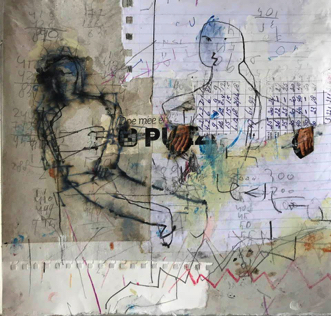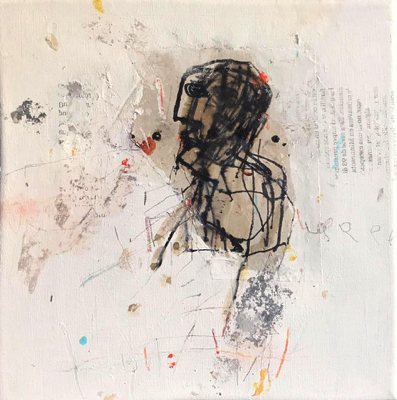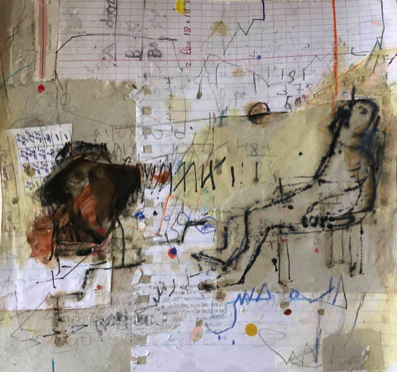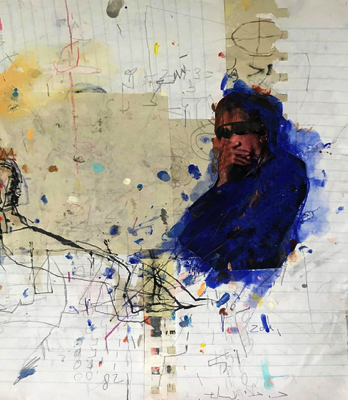



Significance of Colours in the worksof Ali Rashid*
Saleh Razzouk** (with Scott Minar***)
Lately the artist Ali Rashid moved from economizing colours to elaborate with it.
I don not mean he started in vain to explode with colours, I think he is still limiting colour expansion at the expense of other elements, since his colours are still about the same vision, between two poles, the black and the ash. All simple shades of grey, either dotted or granular.
You do not determine to what this sea of grey colour means, is it clouds in a sky of burning city, or a sign of storm, or maybe only wings cross the sky, preparing itself to rain??.
You can not interpret the shapes that Ali Rashid creates, nor his use of elements, the colours and their areas inside the painting, without a reference to the psychological dialectic. He is always in need to refrain his temper, experiencing meantime massive stress and strain. Relying in interpretation task on the viewer who is the real subject of parallel or counter interpretation.
But it is important to remember here that Nathalie Sarout dealt with depression and ill feelings in her elegant book (emotions). Followed by the Sudanese Amir Taj Elssir who called these ambiguous feelings (Tensions) linking them to a division the Sudanese society suffered from, and a lack of solution for the decline and deterioration. Or in direct word: reasons of the collapse.
I can not take Ali Rashid out of this context, yet he is receptive of more divisions, refusing him self, clashing with it, add to it the idle economy and ideology that surrounded Europe itself.
Ali Rashid is a moving artist, like any Sinbad, but he bore his ship on his back, the ship in here is Noah’s Ark, to denote the feelings of fear that all Europeans suffer from. The same feelings the existentialists discussed giving it fewer titles and names like: despair, alienation, outsider, etc…
Since the contemporary self is a vintage of wars, and the contemporary man lives in the shadow of a fear from a repetition before a fall in the hole of chaos and disintegration.
Ali Rashid wanted to minimize the tormented experience in his new paintings. Then he chose for every space similar colours, maintaining in between dialogues with it, in another word, the significance of colours was the factor in action, and I can not find a stranfe behavior in this logic bearing in mind that the banners of states seldom have pictures or symbols of animals and plants.
But I believe that Ali Rashid did not drop out the role of symbols and pictures entirely, he kept it in secret only.
His colours usually develop in depth and size gradually not with sudden sharp angles. You can see it dissipated on the background with different thickness of paints and shades giving the viewer a chance to realization.
No matter how many times we tried to determine his nature our vision would fail us. No place for absolute truth in Ali Rashid’s paintings. Every thing moves potentially, and in my opinion he is engaged with trends not individuals. These trends are part of the continuous adventure of what Zygmunt Bauman calls (liquid Modernity). More importantly the background of paintings is similar to curtains of mono colour, white mostly, so you fail to see what is happening behind it or what is initiating before it. Mean time you have to keep in mind that what we see before the curtains is of two kinds.. colourful deceptive spaces enlarges in our thoughts, we the united entities with the work, not the separated entities. more, inside the closed space we feel and negotiate the strains of life with erection and willingness. Since it is a life of confrontation and never ending efforts.
The columns he made were thin like a ray or little stalk. Non was deprived of feelings rather full with wish for survival and self expression. All were web like but not a spider web or vessels in a plant leaf.
Add to it pictures of standing humans< mostly submerged in the daily matters, or what I like to call: the mill of life. But we must understand his pictures are collages look like floating shapes in the middle of oceans of feelings and senses. These collages are not always the same.
In the blue period (2011 and before) the higher space infiltrates the lower one (the oceans and the skies for example). Again it puts together simple pictures (a page of a book, a stamp, a piece of news paper, an envelope and so on…).
Now it happened to be head of a boy, face in a mirror, man in full length. Some are obvious and separated from the psychological dilemmas , others are disintegrated and rotten and you see out of it the out lines and configurations only. Occasionally intertextuality is there (and I take literally) with previous well known paintings ( like the painting where different pictures and colours trapped the Mona Lisa).
More the shadows and the pictures occupy a corner of the square. It suggests imbalance in colours and shapes distribution. Some thing one can understand in the light of the chaos took over in the west where justice is selective, the peace occasional before a spread of smokes and symbols of devastation and wars. Remember the ox and companies fights.
The world of Ali Rashid id circular, consists of subconscious and beyond. I think the motes and dark spots that float in brighter shades reveal his desire to penetrate the hidden. It motivated us to react with his works where he negated the reality with counter reality, the existence with the escape from life tensions, and from the meaning that is forced on us by mind. If you want the truth he was engaged with efforts to escape from the subject and the object altogether, anchoring him self in memories, the trace and anti trace, and in repressed desires.
Actually he does not want to see his atomized world, or at least he is not ready to confess of his real life, as to draw curtains of alienation on it. Or let us say of puzzling attitudes. I am certain that paved his way for series of displacements. He is back to the same items, to blow in it different thoughts after medications.
werk of artist Ali Rashid
**assistant prof. at The University Of Aleppo, Syria. Lives in UAE.
***prof. at The University of Ohio, Lancaster, USA.

